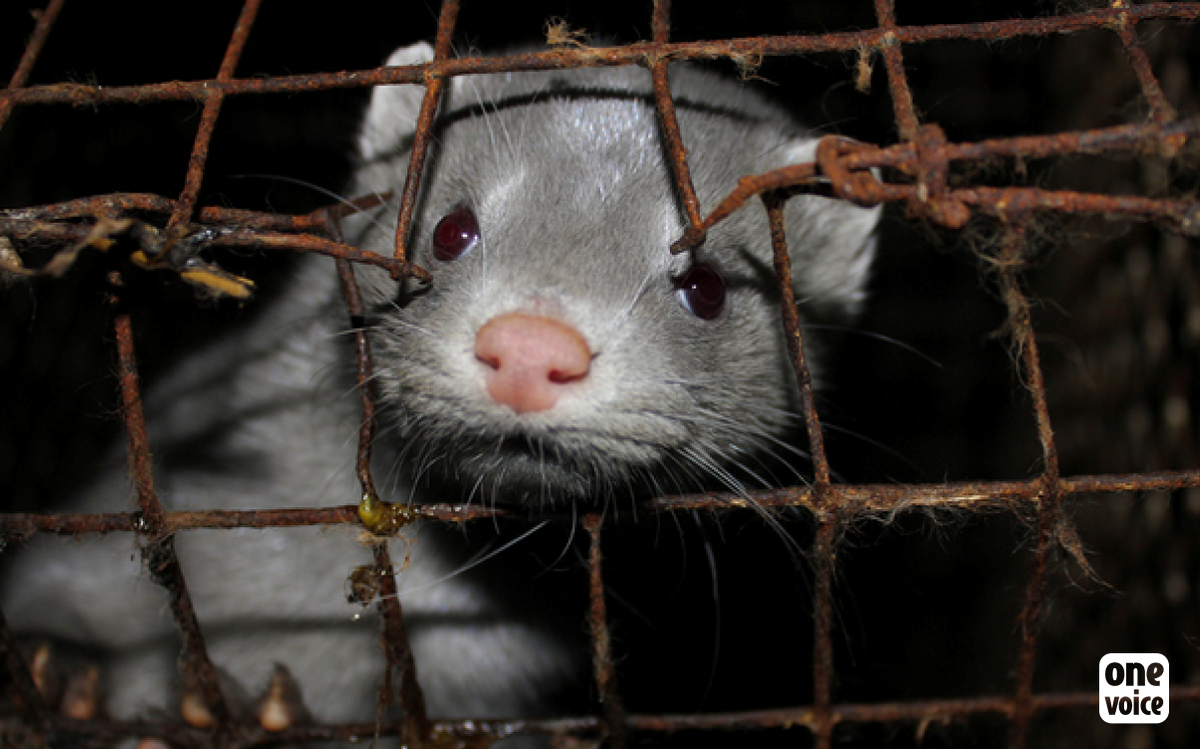

A mink far from his river
One Voice is steadfastly opposed to the fur industry that is responsible for torturing cats, dogs, foxes, chinchillas and other victims of fashion (see the history of our fight here). The mink example demonstrates just how cruelly different from the natural environment these fur farms are. It is really time that France bans these fur farms, as have Holland, the United Kingdom and Denmark.
Minks are independent creatures: living a secluded life on their territory of three or four kilometres along the watercourse. The male only leaves in Spring to meet neighbouring females, who accommodate them and two to three other suitors in their domain. The females raise their annual litter of a half a dozen babies on their own. No fight will stop a reproductive male, sometimes coming from far away.
The rest of the time, the solitary mink roams on the humid ground, the muddy banks, the lakeside or on a sleepy branch of a creek. In this little universe he scampers in silence, day and night, his long supple body snaking through a forest of reeds or diving into the dark water of a pond. He catches a frog, a bird in flight. Below the surface, his long whiskers detect crayfish movement and on the bank, the shrew cannot hide from his sharp intuition, or his refined hearing. He chooses how he lives his life, on his own. He doesn’t need anyone. The stomach full, he returns to his nest under a tree stump to rest, a burrow stolen from a river rat. Minks don’t live long, some six or seven years only, but they live a calm and perfect life, made up of fishing, hunting and adventures.
From birth however, the captive mink has a different life. It doesn’t take him long to get to know his jail: a rectangular cage, 70cm long, 40cm wide and 45cm high, constructed from metal grill, including the floor. The little ones feet get scratched on this structure, passing through the gaps. A bit of water drips from an old tube, some meat is thrown at them once a day, occasionally including the flesh of dead minks. Under the cages, mountains of excrement accumulate, emitting a foul odour. If he climbs up the iron wires, the little mink can sometimes see around, in the immense hangar, the hundreds of cages like his lined up as far as he can see. To live piled up together is a nightmare for the solitary mink, but the absence of water to swim in is also dreadful. The inmates comfort themselves by reproducing mad behaviour; an endless sequence of jumps and movements, repeating the same senseless dance in these tiny cages.
Some burrow into a corner, the tail sliced off, the back bleeding, the eye torn out, or worse. Others no longer move, dead amongst the living, their cannibalised flesh covered in blue flies. Brute violence reigns here, there is constant noise, and cries, fear, and death.
At around eight months of age, having reached the size of an adult with a beautiful winter coat, men with thick gloves grab them with a claw. They are thrown together into a crate on wheels pushed between the cages on the central bay. When the lid is closed, a lethal gas suffocates the minks who jump in all directions against the observation window. Death is sometimes slow for these animals, who are capable of staying underwater for a quarter of an hour whilst holding their breath. Some breeders break the animal’s necks or administer them with a lethal injection.
75 generations of tortured minks have not been sufficient to transform this wild mustelidae into a domestic animal. Originally hunted by trappers, the American mink has been raised in fur farms since 1872. Not arriving in Europe until 1926, small breeders everywhere launched themselves into the lucrative luxury fur business. Bankrupted by the war, thousands of minks were released into the nature. When released, some die of stress, but most quickly adapt to wild life.
Even today, many minks manage to escape the farms and swell an already invasive population. They are also sold as pets where they are often freed as it proves to be difficult to keep a semi-aquatic predator in their living room.
This invasion of farmed minks is having a negative impact on the European mink. Smaller and more nocturnal, it has not been exploited by the fur industry, but is in danger as a result of it.